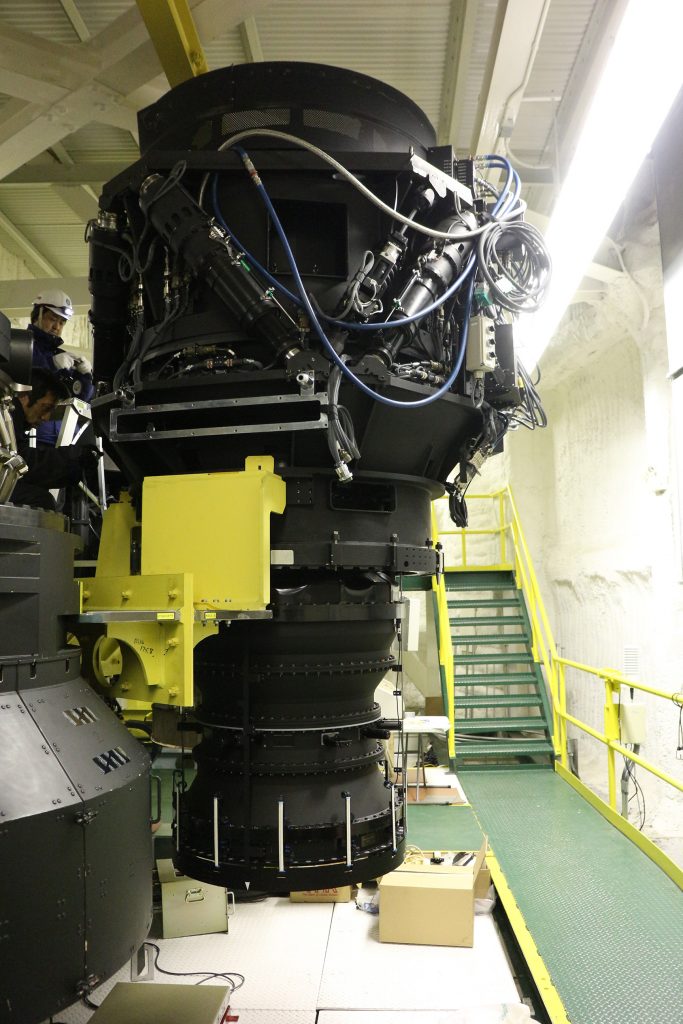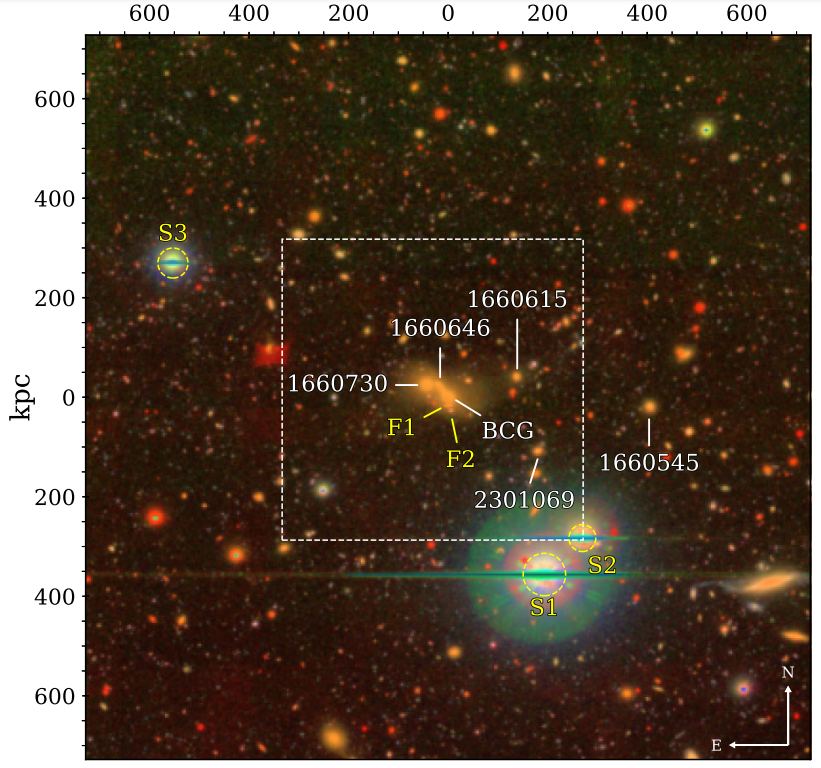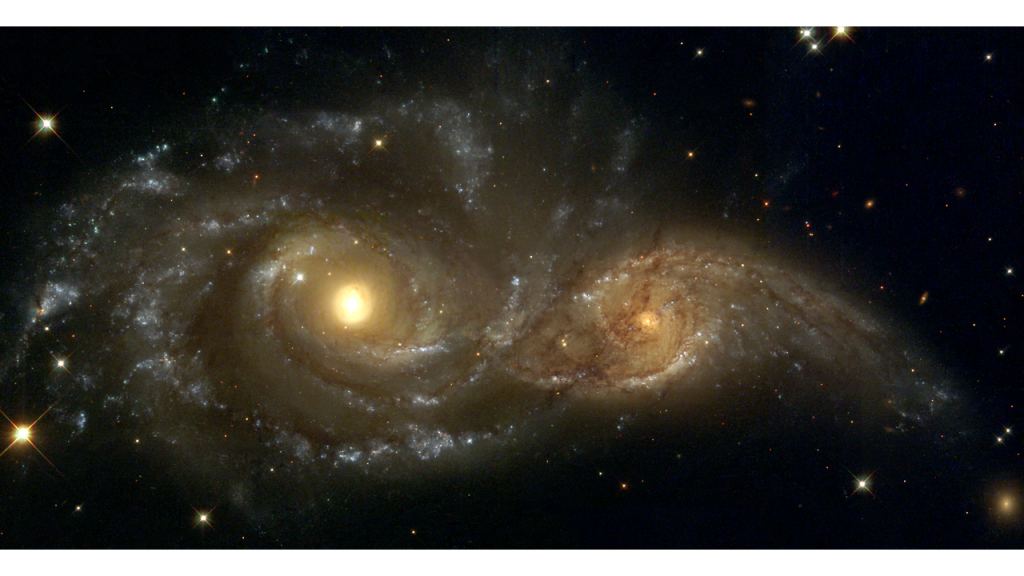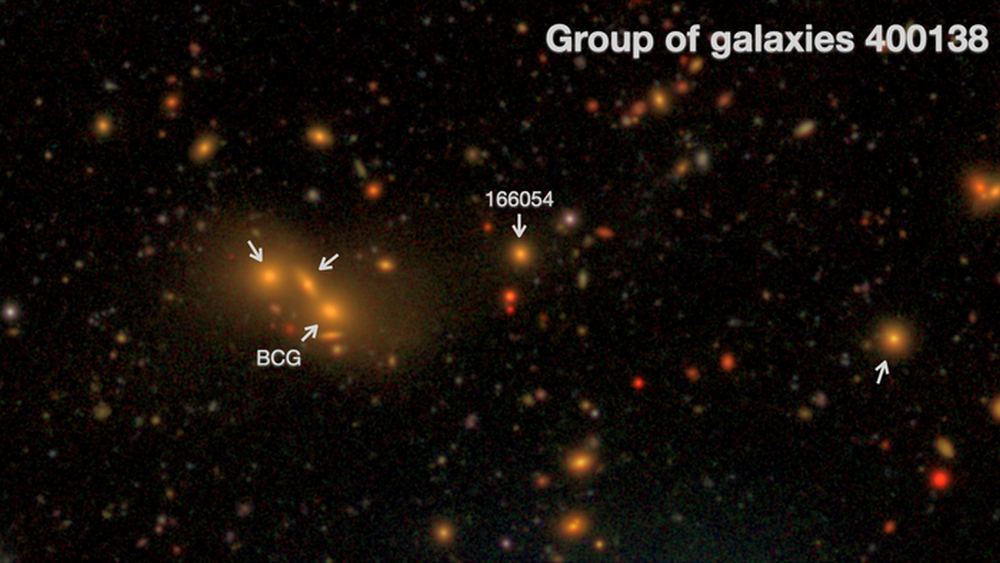Not all stars are members of galaxies. Some stars exist in the space between galaxies, though they didn’t form there. They’re called intra-group stars, and astronomers study them by observing their light, called intra-group light (IGL.)
They’re challenging to observe because their light is extremely faint and overpowered by the light of nearby galaxies.
Astronomers sometimes refer to these intra-group stars as orphans. They formed inside a galaxy somewhere, then were somehow set loose into intergalactic space. The most likely cause is gravitational interaction between galaxies that are merging or passing close by each other.
A team of astronomers developed a new technique to observe IGL and presented their results in a paper. It’s titled “Galaxy And Mass Assembly (GAMA): extended intragroup light in a group at z = 0.2 from deep Hyper Suprime-Cam images.” The Monthly Notices of the Royal Astronomical Society (MNRAS) published the work, and the lead author is Dr. Cristina Martínez-Lombilla from the School of Physics at the University of New South Wales in Australia.
“The brightest parts of the intra-group light are ~50 times fainter than the darkest night sky on Earth,” Dr. Martínez-Lombilla said in a press release. “It is extremely hard to detect, even with the largest telescopes on Earth – or in space.”
The Hyper Suprime Cam (HSC) was primarily developed by the National Astronomical Observatory of Japan (NAOJ) with the involvement of other organizations. It’s an enormous digital camera attached to the Subaru Telescope. The Subaru Telescope is an 8.2-meter optical-infrared telescope at the summit of Maunakea, Hawai?i.

The HSC is huge. It weighs three tons and is taller than a person. It’s an 870-megapixel camera that covers a 1.5° field of view. It’s been operating since 2013 and is on its third public data release.
The new paper is a case study into the HSC and how it can be used for “… the analysis of extended faint structures within groups of galaxies,” as the authors explain. The team examined images from the GAMA (Galaxy And Mass Assembly) survey. GAMA is a wide-field survey that studies galaxy formation and evolution. Several ground-based and space-based facilities contributed to GAMA, and the team combined data from GAMA and the HSC in their study.
The work focuses on a group of galaxies denoted by number only: 400138. The group is very distant, and observing the light is like looking back in time 2.5 billion years. The group is at redshift z=0.2. That means the galaxies in the Universe were 20% closer together than they are now when they emitted the light. That light is just reaching us now.
400138 is a fairly loose group of galaxies, with three galaxies making up its dense core: 1660730, 1660646, and BCG (Bright Cluster Group.)
Even though galaxy group 400138 is considered a fairly loose group, the core is dense. Galaxies in these associations interact gravitationally with one another, and those interactions tear stars from their original galaxies and leave them orphaned in the space between galaxies. Astronomers can’t view these individual stars. They’re much too faint for any observatory to sense them. But as a group, they give off enough light to observe if you have the proper technique.
This team of astronomers developed a method to remove the light from the galaxies and leave the light from the stars. Astronomers call this light intra-group light (IGL) or intracluster light (ICL.)
“We have developed a tailored image treatment procedure that allows us to analyze the faintest structures in the Universe,” said Dr. Martínez-Lombilla. “It follows the standard steps for the study of faint structures in astronomical images – which implies 2D modelling and the removal of all light except that coming from the intra-group light. This includes all the bright stars in the images, the galaxies obscuring the intra-group light and a subtraction of the continuum emission from the sky.”

“The most important outcome is that when studying very faint structures around galaxies, every step in the process counts and every undesirable light should be accounted for and removed. Otherwise, your measurements will be wrong,” Dr. Martínez-Lombilla said.
Removing unwanted light is a common theme in astronomy. But unlike other techniques, this one is modular and can be “transported” to different applications and still be effective.
“What makes our technique different is that it is fully Python-based, so it is very modular and easily applicable to different sets of data from different telescopes rather than being just useful for these images,” said Dr. Martínez-Lombilla.

Astronomers are interested in IGL because it’s like a fossil record of the interactions between galaxies. By studying the amount of IGL and its properties, researchers can piece together the history of the galaxies and how they evolved. If this pilot study proves effective, it shows that the Hyper Suprime-Cam can be a powerful tool for studying galactic evolution.
Martínez-Lombilla and her colleagues found that the inter-group stars had different properties than the bulk of the stars in the nearby galaxy groups. They’re both younger and less metal-rich.
“We analyzed the properties of the intra-group stars – those stray stars between the galaxies. We looked at the age and abundance of the elements that composed them, and then we compared those features with the stars still belonging to galaxy groups,” Dr. Martínez-Lombilla said. “We found that the intra-group light is younger and less metal-rich than the surrounding galaxies.”
These results are in line with some of what we know about galaxy interactions. “These results are consistent with tidal stripping of the outer parts of Milky Way-like galaxies as the main driver of the IGL build-up,” the authors explain in their paper. “This is supported by the detection of substructure in the IGL towards the galaxy member 1660615, suggesting a recent interaction (<1 Gyr ago) of that galaxy with the core of the group,” they write.
The orphan stars have different properties than the stars in the three nearby core galaxies BCG, 1660730, and 1660646. Instead, they’re similar to the stars in the tail of a more distant galaxy named 1660615, seen in the composite image. They were likely stripped from their galaxy of origin but are still gravitationally bound to the overall group.
“We think these individual stars were at some points stripped from their home galaxies, and now they float freely, following the gravity of the group,” said Dr. Martínez-Lombilla. “The stripping, called tidal stripping, is caused by the passage of massive satellite galaxies – similar to the Milky Way – that pull stars in their wake.”

This pilot study is the first time astronomers have observed IGL from this galaxy group. The observations allow the team to begin to piece together the interaction histories of the galaxies that comprise it.
“Unveiling the quantity and origin of the intra-group light provides a fossil record of all the interactions a group of galaxies has undergone and provides a holistic view of the system’s interaction history,” Dr. Martínez-Lombilla said.
“Also, these events occurred a long time ago. The galaxies [we’re looking at] are so far away that we’re observing them as they were 2.5 billion years ago. That is how long it takes for their light to reach us.”
The formation and evolution of galaxies is an essential topic in astronomy. The Universe began as plasma and somehow evolved into what we see today. The Large-Scale Structure of the Universe shows how matter is organized into more extensive patterns than individual galaxies or even groups of galaxies. Some of these structures are billions of light-years in length.

But individual galaxies are the granular components of the large-scale structure, and stars are even more granular. And for a civilization like ours, stars dominate our lives and our foreseeable future. The effort to understand intra-group light is the effort to understand the context of our own galaxy, Solar System, and even our own civilization and its far-reaching future. Whatever forces govern the evolution of the distant galaxies in the study also govern the evolution of the Milky Way.
The team considers their pilot study a success and wants to expand their efforts.
“Our main long-term goal is to extend these results to a large sample of groups of galaxies. Then we can look at statistics and find out the typical properties regarding the formation and evolution of the intra-group light and these extremely common systems of groups of galaxies,” Dr. Martínez-Lombilla said.
Their work could play a role in future large-scale surveys like the Legacy Survey of Space and Time (LSST) that the upcoming Vera Rubin Observatory will perform. That effort will take ten years and will image billions of objects. Astronomers expect one million of them to be galaxy groups at z = 1. That large number would be the basis for a large, statistically significant sample of galaxy groups.
If the team can bring their method of studying intra-group light to bear on the LSST, it’ll add value to the effort and help us build a clearer picture of galaxy evolution.
More:
- Press Release: Astronomers observe intra-group light – the elusive glow between distant galaxies
- Paper: Galaxy And Mass Assembly (GAMA): extended intragroup light in a group at z = 0.2 from deep Hyper Suprime-Cam images.
- Universe Today: Plenty of Examples That Giant Galaxies Like the Milky Way Formed Through Mergers

